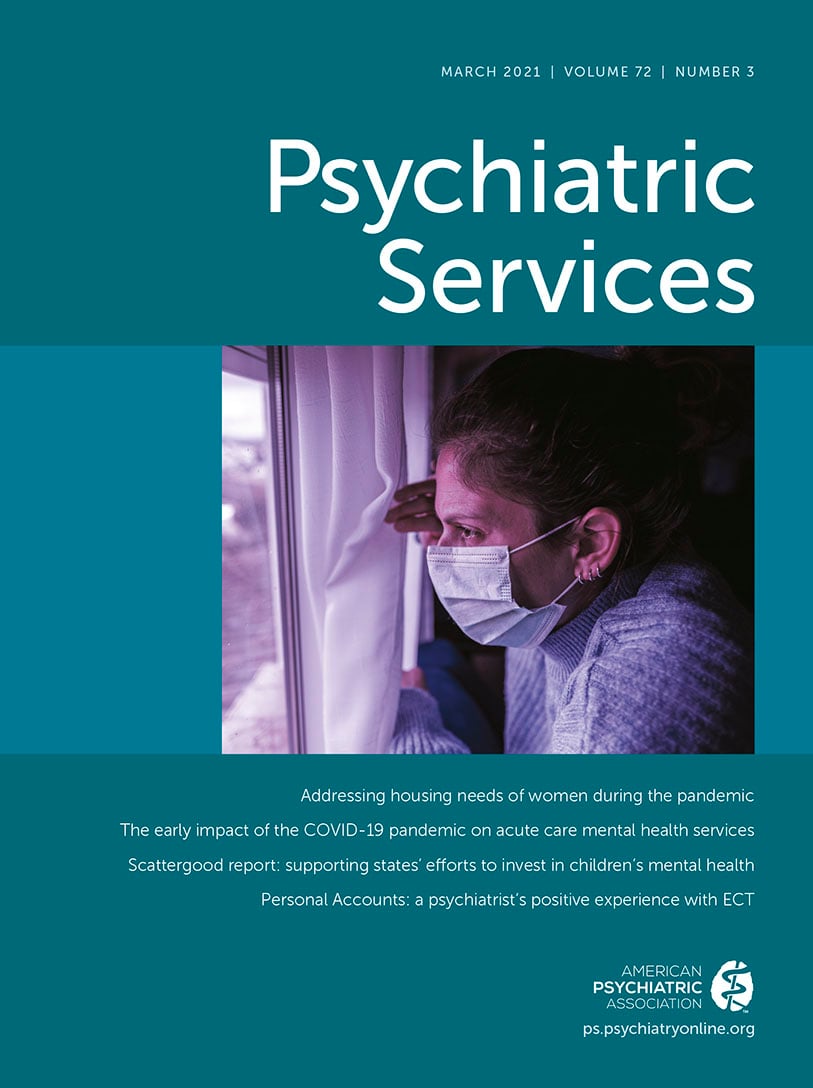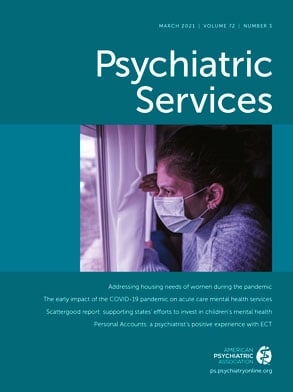Psychotropic polypharmacy is sometimes used to reduce symptoms that have not responded to first-line treatments, to facilitate cross-titration, or to treat multiple distinct conditions. It also may be deployed after other interventions have proven ineffective or are poorly tolerated (
1). As the number of medications a patient receives increases, adverse effects and drug interactions also increase (
2), and no evidence indicates that the benefits of polypharmacy routinely outweigh its risks (
3). Disadvantaged children may be more likely to be prescribed polypharmacy (
1,
3). As a result of these challenges, polypharmacy should be used with children only after careful consideration. This column focuses on children receiving five or more psychotropic medications in an outpatient setting, a patient group about which we could find no previously published information.
Since 2013, the second-opinion program in Washington State has been conducting mandatory child psychiatry second-opinion reviews of polypharmacy regimens for every child covered by Medicaid/Children’s Health Insurance Program (CHIP) (
4). Here, we describe the clinical features, care, and consultant recommendations of two cohorts (from 2013 and 2018) of consultations. Because the data were obtained from Medicaid pharmacy claims, community clinician records, and prescriber and consultant phone conversations, this study is more complete than studies using claims-only data. An improved understanding of polypharmacy regimens across a state Medicaid system could inform the work of policy makers, administrators, and clinicians to shape the complex care of vulnerable children.
Program Description
Pharmacy claims data that trigger a second-opinion review in Washington include prescription of five or more psychotropic medications, including anticonvulsants and alpha-2 agonists. When the review is triggered, the Washington State Health Care Authority (i.e., Washington Medicaid) requests that the prescriber submit clinical records and obtain authorization for any suggested treatment changes. The clinical records are forwarded to the state’s second-opinion child and adolescent psychiatry team at Seattle Children’s Hospital. The reviewing psychiatrist inspects the records and acts as a consultant who phones and discusses with the prescriber which best practice care would address the patient’s needs. Consultant advice fell into three categories: change, no change pending outcome of treatment adjustment, or no change. A “change” recommendation may address a safety concern or may improve alignment of the treatment with best practices. “No change pending outcome” means that the polypharmacy regimen is approved with specific adjustments. For example, a patient may be weaned off a medication regimen whose benefits for the patient are unclear, but if the regimen is then found to improve the condition of the patient, use of this regimen may be authorized. “No change” means that the consultant recommends approval of the regimen without restriction, although the consultant may make additional suggestions about care. The child psychiatrist consultant writes a summary of the consultation, and Washington Medicaid then decides whether to authorize continued use of or a change in the medication regimen.
Procedure
The research team for this study consisted of three child and adolescent psychiatrists who also conducted the second-opinion reviews. Second-opinion reviews from January 1–December 31, 2013, and January 1–December 31, 2018, were identified. The research team reviewed the authorization request and clinical records dated up to 3 months before the date of the phone consultation to collate relevant clinical information for the study. An institutional review board approved the study.
Data were analyzed to descriptively summarize the characteristics gathered from the second-opinion review. The chi-square test for categorical variables was used to assess differences in diagnoses, medication use, and psychosocial treatment between the two periods (
5).
Results
Medicaid forwarded 513 second-opinion review requests during the two periods studied. Of these, 208 (41%) pertained to patients who no longer received five or more psychotropic medications, resulting in 136 reviews from 2013 and 169 from 2018 that were included in this study, representing 0.02% of the Washington child Medicaid/CHIP population (N=1,739,111). Over this time, Medicaid/CHIP child enrollment in Washington State increased 12% (
6).
In 2013 and 2018, the polypharmacy prescriber was a pediatrician or family practitioner in 23 (17%) and 31 (18%) reviews, respectively, and a psychiatrist or psychiatric nurse practitioner in 111 (82%) and 128 (76%) reviews, respectively. Two prescribers in 2013 and 10 in 2018 described themselves as “other” or “pediatric subspecialist [not a psychiatrist].”
For 29 (21%) and 45 (27%) reviews, the prescribers were nurse practitioners in 2013 and 2018, respectively, and 107 (79%) and 117 (69%) were medical or osteopathy doctors, respectively. In 2018, five (3%) prescribers were physician assistants.
In 2013 and 2018, 91 (67%) and 111 (66%) children were boys, and 45 (33%) and 58 (34%) were girls, respectively; 1 (<1%) and 2 (1%) were 0–5 years old, 34 (25%) and 59 (35%) were 6–11 years old, and 101 (74%) and 108 (64%) were teens, respectively. No information regarding race or ethnicity was collected.
The number of prescribed psychotropic medications varied from five to 10, with means±SD of 5.4±1.4 in 2013 and 5.3±1.5 in 2018.
Table 1 describes the medication types prescribed to the children in 2013 and 2018. Attention-deficit hyperactivity disorder (ADHD) medications, second-generation antipsychotics, and antianxiety medications were most commonly prescribed during both periods studied. The use of non-selective serotonin reuptake inhibitor antidepressants, nonstimulant ADHD medications, and hydroxyzine significantly increased while stimulant use significantly decreased between 2013 and 2018.
Table 2 reports the diagnoses the children received in the two time periods. ADHD, anxiety disorder, oppositional defiant or conduct disorder, and trauma-related disorders were most prevalent in both years, and anxiety statistically significantly increased between 2013 and 2018. The number of diagnoses of mood disorder unspecified or not otherwise specified and bipolar disorder decreased, whereas diagnoses of disruptive mood dysregulation disorder (added to
DSM-5 during 2013) increased.
In 2013, 95 (70%) reviews disclosed that patients also received psychosocial or counseling interventions, and in 2018, 136 (80%) reviews mentioned these interventions, and this increase over time was statistically significant (p=0.03).
In 2013 and 2018, a treatment change was recommended in six (4%) and 23 (14%) consultations, no change pending outcome in 60 (44%) and 80 (47%) consultations, and no change in 70 (52%) and 66 (39%) consultations, respectively.
Discussion
In this study of the second-opinion review program of poly-pharmacy treatments in Washington State in 2013 and 2018, we refined claims data by reviewing clinical records and discussing them with prescribers. We noted discrepancies between claims-flagged regimens and those containing five or more psychotropic medications. Discrepancies were often due to cross-titration or discontinuation before the review because of tolerability or efficacy of the treatment. The discrepancies highlight challenges in capturing accurate prescription regimens through claims data alone.
Despite implementation of the review program, the frequency of polypharmacy regimen reviews did not diminish over the two time periods we selected. Reasons for this lack of a decrease may include improved processes by Medicaid to identify polypharmacy, improved compliance by prescribers with the review process, an increase in severity of mental health difficulties among youths, or more prescribers utilizing complex polypharmacy to treat their young patients (
1,
7,
8).
The diagnoses of the patients commonly included externalizing difficulties, an observation consistent with existing knowledge about when polypharmacy is prescribed (
9). Previously published data have indicated that antipsychotic use (other than in polypharmacy regimens) decreased over this time in Washington State (
4). However, in the group studied here, antipsychotic use rates remained steady. This finding may highlight the severity of difficulties for the children in this polypharmacy group and reliance of prescribers on antipsychotics as one component of the treatment plan.
Anxiety diagnoses were prevalent and increased over time, as did the use of anxiolytics. This finding aligns with evidence that anxiety is increasing among young people and can be a risk marker for other problems, such as depression and suicidality (
10,
11).
Among the patients whose records we reviewed, a history of trauma was prevalent and may have resulted in multiple symptoms and prescription of multiple psychotropic medications. Although talk therapy is of primary importance to address trauma-related difficulties, medications for these conditions may be used at high rates because access to specialized therapy is a challenge in some communities, and community providers may use what is more available to them.
Engagement with psychosocial supports increased significantly. During the review process, second-opinion consultants often asked about and encouraged psychosocial interventions. This shift toward best practice care is a noteworthy outcome of the second-opinion intervention (
3).
Consultants focus on safety when making recommendations and encourage a shift toward best practice when needed. Consultants usually recommended approval for complex psychotropic regimens or gave approval with a caveat, such as a dose reduction or trialing an alternative strategy first. The high approval rates are not surprising given that many regimens were for children in specialist care, representing a population of the most challenging cases.
The limitations of our study include that the diagnoses recorded were not based on a research diagnostic inventory. This may be a strength, however, because the diagnoses reflected perceptions of community prescribers. Another limitation was that the process for flagging regimens for review may have been adjusted during the study period. Prescriber noncompliance may have biased the observed prescribing patterns in the reviews. Such a bias may have made the number of reviews less reliable, but we note that we did not find a downward trend in polypharmacy prescriptions over time.
This study of a statewide Medicaid review program at two time points describes the identification of complex polypharmacy regimens, the diagnoses and treatment plans prescribed to youths mostly by psychiatric specialists, and consultations with child psychiatrists acting as second-opinion reviewers. The review program offering consultation advice did not decrease the number of reviews of polypharmacy use over time. But the program did result in a significant increase in the use of nonmedication-augmented psychosocial or counseling interventions, suggesting a shift toward best practices during this time. Policy makers may learn from these outcomes that a polypharmacy second-opinion consultation program is worth implementing and that increased use of nonpharmacological strategies may support vulnerable children and youths.

